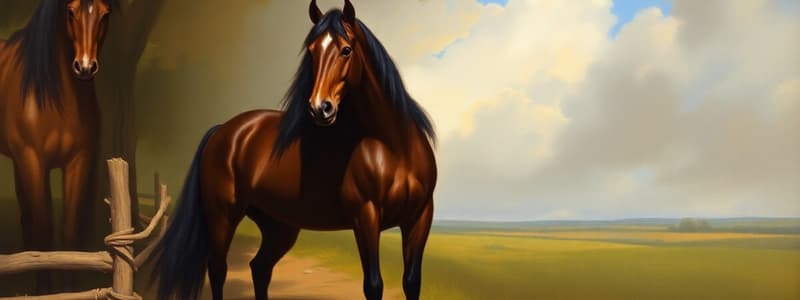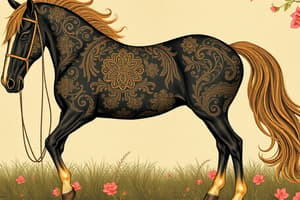Podcast
Questions and Answers
How does 'stress' generally manifest in horses?
How does 'stress' generally manifest in horses?
- As a demand for adaptation unique to each horse's tolerance level. (correct)
- As a consistent, predictable pattern across all horses.
- Exclusively as a result of poor training methods.
- Primarily through changes in coat color and shedding patterns.
A horse exhibits lameness, swelling, and heat in its left foreleg. Under which category of stress would these signs fall?
A horse exhibits lameness, swelling, and heat in its left foreleg. Under which category of stress would these signs fall?
- Nutritional stress
- Mechanical stress (correct)
- Behavioral stress
- Immunological stress
Which scenario exemplifies how a horse's social behavior might contribute to stress?
Which scenario exemplifies how a horse's social behavior might contribute to stress?
- A horse showing increased alertness and reactivity to loud noises during a thunderstorm.
- A new horse being introduced into an established herd and challenging the existing social order. (correct)
- A horse consistently refusing to enter a trailer due to past travel experiences.
- A horse developing laminitis due to a diet high in sugars and starches.
What role does the 'Jockey Club' play in the identification of horses?
What role does the 'Jockey Club' play in the identification of horses?
Why is maintaining an 'ownership file' crucial in minimizing horse theft?
Why is maintaining an 'ownership file' crucial in minimizing horse theft?
Which neonatal procedure involves the use of tincture of iodine solution?
Which neonatal procedure involves the use of tincture of iodine solution?
What is the primary purpose of administering a foal enema as a neonatal procedure?
What is the primary purpose of administering a foal enema as a neonatal procedure?
Why is it generally recommended that a mare be released first into a pasture before her foal?
Why is it generally recommended that a mare be released first into a pasture before her foal?
Which factor is least relevant when determining the 'timing' for turning out a mare and foal for the first time?
Which factor is least relevant when determining the 'timing' for turning out a mare and foal for the first time?
What is a common characteristic of 'abrupt separation' in the context of weaning foals?
What is a common characteristic of 'abrupt separation' in the context of weaning foals?
At what age is castration typically performed on horses?
At what age is castration typically performed on horses?
What best describes a 'cryptorchid' or 'ridgeling' in the context of castration?
What best describes a 'cryptorchid' or 'ridgeling' in the context of castration?
Why is being 'unpalatable' considered a desirable quality in bedding for horses?
Why is being 'unpalatable' considered a desirable quality in bedding for horses?
Besides good sanitation practices, what methods can be used for fly control?
Besides good sanitation practices, what methods can be used for fly control?
Why is understanding the life cycles and habits of different fly species important for effective fly control?
Why is understanding the life cycles and habits of different fly species important for effective fly control?
How does 'clipping' pastures regularly contribute to sound pasture management?
How does 'clipping' pastures regularly contribute to sound pasture management?
Why is it important to avoid both 'overgrazing' and 'undergrazing' in pasture management?
Why is it important to avoid both 'overgrazing' and 'undergrazing' in pasture management?
How can applying lime and fertilizer improve pasture quality?
How can applying lime and fertilizer improve pasture quality?
What is the primary purpose of performing a soil test before pasture renovation?
What is the primary purpose of performing a soil test before pasture renovation?
Why are horses considered 'extremely susceptible' to molds and fungi in their forage?
Why are horses considered 'extremely susceptible' to molds and fungi in their forage?
Which characteristic is least likely to be associated with wound overview?
Which characteristic is least likely to be associated with wound overview?
What characterizes a 'contaminated' wound?
What characterizes a 'contaminated' wound?
Permanent records for horses would include what information?
Permanent records for horses would include what information?
What method of identifying a horse involves altering skin pigmentation?
What method of identifying a horse involves altering skin pigmentation?
Why is maintaining records of deworming dates and products used essential for horse management?
Why is maintaining records of deworming dates and products used essential for horse management?
Which of the following best describes how a horse's hearing can be a source of stress?
Which of the following best describes how a horse's hearing can be a source of stress?
Which factor is most important when considering methods of marking and identifying horses?
Which factor is most important when considering methods of marking and identifying horses?
What is the primary reason for keeping accurate records of a horse's allergy causes?
What is the primary reason for keeping accurate records of a horse's allergy causes?
What is the primary goal of stress management in horses?
What is the primary goal of stress management in horses?
Flashcards
What is stress in horses?
What is stress in horses?
A demand for adaptation. Some is necessary, and each horse has its own tolerance level.
What are the categories of stress
What are the categories of stress
Behavioral, vision, hearing, smell and touch.
What is Communication and Stress?
What is Communication and Stress?
Visual signals and the ability to recognize signs of stress of another fellow horse.
What are the signs of mechanical stress?
What are the signs of mechanical stress?
Signup and view all the flashcards
What can nutrition & metabolic stress cause?
What can nutrition & metabolic stress cause?
Signup and view all the flashcards
What causes Immunological Stress?
What causes Immunological Stress?
Signup and view all the flashcards
What information goes into permanent records?
What information goes into permanent records?
Signup and view all the flashcards
How to identify a horse?
How to identify a horse?
Signup and view all the flashcards
What helps minimize theft of horses?
What helps minimize theft of horses?
Signup and view all the flashcards
How to treat the foal's navel?
How to treat the foal's navel?
Signup and view all the flashcards
Why use a Foal Enema?
Why use a Foal Enema?
Signup and view all the flashcards
What weaning methods are there?
What weaning methods are there?
Signup and view all the flashcards
What is a Gelding?
What is a Gelding?
Signup and view all the flashcards
What is a Cryptorchid (Ridgeling)?
What is a Cryptorchid (Ridgeling)?
Signup and view all the flashcards
Qualities of good bedding?
Qualities of good bedding?
Signup and view all the flashcards
How to control flies?
How to control flies?
Signup and view all the flashcards
Why is Management effort important?
Why is Management effort important?
Signup and view all the flashcards
How to sound manage horse pastures?
How to sound manage horse pastures?
Signup and view all the flashcards
Benefits of lime and fertilizer?
Benefits of lime and fertilizer?
Signup and view all the flashcards
What does complete renovation include?
What does complete renovation include?
Signup and view all the flashcards
What are the Forage Concerns?
What are the Forage Concerns?
Signup and view all the flashcards
Types of wound?
Types of wound?
Signup and view all the flashcards
Study Notes
Common Management Practices
- Successful horse ownership relies on knowledge and good management.
- Management combines knowledge with practical application.
Recognizing Stress in Horses
- Stress is a demand for adaptation which is sometimes necessary.
- Each horse has unique tolerance levels.
Categories of Stress
- Behavioral stress involves vision, hearing, smell, and touch.
- Communication factors include visual and recognizing signals.
- Social behavior consists of herd instinct and social order.
- Mechanical stress factors Lameness, local inflammation, swelling, heat, and pain.
- Nutritional and metabolic stress involves colic, laminitis, and tying up.
- Immunological stress involves disease and/or parasites.
Permanent Records
- Permanent records for horses should include their name, breed, and birth date.
- Additional Important data includes weight, condition scores, deworming dates/products, injury dates/treatments, surgery dates/outcomes, and allergy causes.
Marking or Identifying Horses
- Proper horse identification holds high priority.
- The Jockey Club was the first US organization to establish accurate identification.
Methods to Identify a Horse
- Common methods include body markings, tattooing, and freeze branding.
- Blood typing, DNA testing, and microchip implantation offer added identification
Minimizing Theft of Horses
- Permanent markings help track horses.
- An ownership file should contain registration papers, a dated bill of sale, photographs, and descriptions of unique characteristics.
Neonatal Procedures
- Navel treatment involves tincture of iodine solution and natural severance.
- A foal enema prevents impacted meconium and stimulates intestinal peristalsis.
Mare and Foal Exercise
- Timing the mare and foal's first turnout depends on climate, foaling time, and weather.
- The mare should be released first and will usually run and kick.
Weaning and Castration
- Weaning can be stressful for foals.
- The foal should be in good health at weaning time.
- Weaning methods include abrupt and gradual separation.
- A castrated horse is called a gelding and can be castrated at any age, most frequently between birth and 2 years of age.
- Cryptorchid or ridgeling horses have one or both undescended testes and can be difficult to castrate.
Bedding
- Bedding qualities include being absorbent, dust-free, readily available, easily disposable, unpalatable, and affordable.
Fly Control
- Fly control relies on sound sanitation with proper stable or corral maintenance.
- Other fly control includes chemical and biological intervention.
Management Efforts
- Management efforts are needed to control diverse fly types.
- It includes understanding the life cycles and habits of horseflies, deerflies, blackflies, biting gnats/midges, horn flies, and nuisance flies.
Management of Pastures
- Horses thrive when allowed to graze.
- Sound pasture management prevents over/undergrazing, clipping pastures regularly, chain-link harrowing, and fertilizer.
Pasture Improvement
- Lime and fertilizer application can double yield.
- Complete renovation involves soil testing, destroying/suppressing old pastures and appropriate seeding methods.
Forage Concerns
- Horses are very susceptible to molds, fungi, and toxic substances in forage.
- Other forage issues include blister beetles and poisonous plants.
Wound Management and Basic First Aid
- Key characteristics include elevated/below-normal temperature, increased pulse, mucous membrane color, and capillary refill time.
- Wound classifications include clean, contaminated, infected, open, and closed.
Summary
- Stress can arise from mechanical injury, poor nutrition, and disease.
- Positive identification deters theft/fraud and is required for insurance.
- Proper management sustains productive pastures and enhances poor pastures via renovation.
Studying That Suits You
Use AI to generate personalized quizzes and flashcards to suit your learning preferences.



